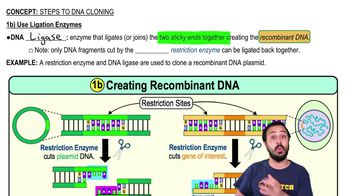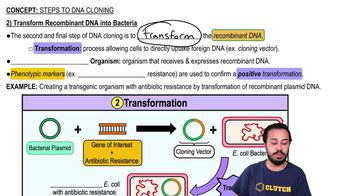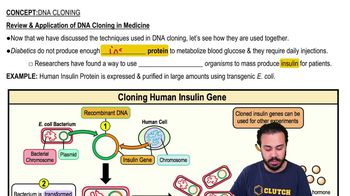Table of contents
- 1. Introduction to Biology2h 42m
- 2. Chemistry3h 40m
- 3. Water1h 26m
- 4. Biomolecules2h 23m
- 5. Cell Components2h 26m
- 6. The Membrane2h 31m
- 7. Energy and Metabolism2h 0m
- 8. Respiration2h 40m
- 9. Photosynthesis2h 49m
- 10. Cell Signaling59m
- 11. Cell Division2h 47m
- 12. Meiosis2h 0m
- 13. Mendelian Genetics4h 44m
- Introduction to Mendel's Experiments7m
- Genotype vs. Phenotype17m
- Punnett Squares13m
- Mendel's Experiments26m
- Mendel's Laws18m
- Monohybrid Crosses19m
- Test Crosses14m
- Dihybrid Crosses20m
- Punnett Square Probability26m
- Incomplete Dominance vs. Codominance20m
- Epistasis7m
- Non-Mendelian Genetics12m
- Pedigrees6m
- Autosomal Inheritance21m
- Sex-Linked Inheritance43m
- X-Inactivation9m
- 14. DNA Synthesis2h 27m
- 15. Gene Expression3h 20m
- 16. Regulation of Expression3h 31m
- Introduction to Regulation of Gene Expression13m
- Prokaryotic Gene Regulation via Operons27m
- The Lac Operon21m
- Glucose's Impact on Lac Operon25m
- The Trp Operon20m
- Review of the Lac Operon & Trp Operon11m
- Introduction to Eukaryotic Gene Regulation9m
- Eukaryotic Chromatin Modifications16m
- Eukaryotic Transcriptional Control22m
- Eukaryotic Post-Transcriptional Regulation28m
- Eukaryotic Post-Translational Regulation13m
- 17. Viruses37m
- 18. Biotechnology2h 58m
- 19. Genomics17m
- 20. Development1h 5m
- 21. Evolution3h 1m
- 22. Evolution of Populations3h 52m
- 23. Speciation1h 37m
- 24. History of Life on Earth2h 6m
- 25. Phylogeny2h 31m
- 26. Prokaryotes4h 59m
- 27. Protists1h 12m
- 28. Plants1h 22m
- 29. Fungi36m
- 30. Overview of Animals34m
- 31. Invertebrates1h 2m
- 32. Vertebrates50m
- 33. Plant Anatomy1h 3m
- 34. Vascular Plant Transport1h 2m
- 35. Soil37m
- 36. Plant Reproduction47m
- 37. Plant Sensation and Response1h 9m
- 38. Animal Form and Function1h 19m
- 39. Digestive System1h 10m
- 40. Circulatory System1h 57m
- 41. Immune System1h 12m
- 42. Osmoregulation and Excretion50m
- 43. Endocrine System1h 4m
- 44. Animal Reproduction1h 2m
- 45. Nervous System1h 55m
- 46. Sensory Systems46m
- 47. Muscle Systems23m
- 48. Ecology3h 11m
- Introduction to Ecology20m
- Biogeography14m
- Earth's Climate Patterns50m
- Introduction to Terrestrial Biomes10m
- Terrestrial Biomes: Near Equator13m
- Terrestrial Biomes: Temperate Regions10m
- Terrestrial Biomes: Northern Regions15m
- Introduction to Aquatic Biomes27m
- Freshwater Aquatic Biomes14m
- Marine Aquatic Biomes13m
- 49. Animal Behavior28m
- 50. Population Ecology3h 41m
- Introduction to Population Ecology28m
- Population Sampling Methods23m
- Life History12m
- Population Demography17m
- Factors Limiting Population Growth14m
- Introduction to Population Growth Models22m
- Linear Population Growth6m
- Exponential Population Growth29m
- Logistic Population Growth32m
- r/K Selection10m
- The Human Population22m
- 51. Community Ecology2h 46m
- Introduction to Community Ecology2m
- Introduction to Community Interactions9m
- Community Interactions: Competition (-/-)38m
- Community Interactions: Exploitation (+/-)23m
- Community Interactions: Mutualism (+/+) & Commensalism (+/0)9m
- Community Structure35m
- Community Dynamics26m
- Geographic Impact on Communities21m
- 52. Ecosystems2h 36m
- 53. Conservation Biology24m
18. Biotechnology
Steps to DNA Cloning
Problem 8`
Textbook Question
Which of the following sequences in double-stranded DNA is most likely to be recognized as a cutting site for a restriction enzyme?
a. AAGG TTCC
b. GGCC CCGG
c. ACCA TGGT
d. AAAA TTTT
 Verified step by step guidance
Verified step by step guidance1
Understand that restriction enzymes recognize specific sequences in DNA, often palindromic sequences, which are the same when read 5' to 3' on both strands.
Examine each option to determine if it is a palindromic sequence. A palindromic sequence reads the same forwards and backwards on complementary strands.
Option a: AAGG TTCC is not palindromic because the sequence does not read the same forwards and backwards.
Option b: GGCC CCGG is palindromic because when you read the sequence 5' to 3' on both strands, it is the same.
Option c: ACCA TGGT and option d: AAAA TTTT are not palindromic. ACCA TGGT does not read the same forwards and backwards, and AAAA TTTT, while symmetrical, is not typically recognized by restriction enzymes.
 Verified video answer for a similar problem:
Verified video answer for a similar problem:This video solution was recommended by our tutors as helpful for the problem above
Video duration:
2mPlay a video:
Was this helpful?
Key Concepts
Here are the essential concepts you must grasp in order to answer the question correctly.
Restriction Enzymes
Restriction enzymes, also known as restriction endonucleases, are proteins that cut DNA at specific sequences. These enzymes recognize short, palindromic DNA sequences, which are the same when read forwards and backwards on complementary strands. They are essential tools in molecular biology for DNA manipulation and cloning.
Recommended video:
Guided course

1a) Use Restriction Enzymes
Palindromic Sequences
A palindromic sequence in DNA is a sequence of nucleotides that reads the same in both directions on complementary strands. For example, the sequence 'GAATTC' is palindromic because its complementary strand is 'CTTAAG', which reads the same in reverse. These sequences are often recognized by restriction enzymes as cutting sites.
Recommended video:
Guided course

Dideoxy Sequencing
DNA Double Helix Structure
The DNA double helix consists of two complementary strands of nucleotides twisted around each other. Each strand is composed of a sugar-phosphate backbone and nitrogenous bases (adenine, thymine, cytosine, and guanine) that pair specifically (A with T, C with G). Understanding this structure is crucial for identifying palindromic sequences and restriction enzyme sites.
Recommended video:
Guided course

Discovering the Structure of DNA
Related Videos
Related Practice














![[LECT C8 : RECOMBINANT DNA TECHNOLOGY] 8.2 Steps in Gene Cloning](https://img.youtube.com/vi/T1l-StLrDwg/mqdefault.jpg)

